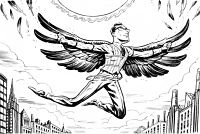The line between confidence and hubris. (2016)

Four early signals from a prospective CEO’s behavior help… predict failure or success.
Tim Lasseter, advisor at Strategy&, PwC’s strategy consulting business and University of Virginia professor
strategy+business, 21 Nov 2016
Illustration: Lars Leetaru
“It is rare for a week to pass without a newspaper or magazine offering a tale of the mistaken path of a fallen business executive, quoting critics who explain the errors that led to the failure. However, investors and boards of directors responsible for selecting a CEO don’t have the luxury of hindsight. They should, ideally, identify any shortcomings in their prospective CEO before there is trouble, not after the fact. This is no easy task. Is there some predictable fatal flaw that distinguishes responsible risk taking from something reckless or even sinister?
“One field of academic research suggests an answer: executive hubris. Hubris, defined as excessive self-confidence or pride, leads CEOs to make overly risky bets, or to ignore relevant warning signs and fail to invoke contingency plans. The problem, of course, is that the difference between justifiable and excessive self-confidence generally becomes evident only after the damage is done. And most incoming chief executives have pride and self-confidence well above normal levels, and with good reason…
“Four early signals can help in navigating these muddy waters. The first two, narcissism and dismissiveness, are warning signs of hubris. The other two, humility and inquisitiveness, are promising signs of justifiable confidence.”
Access the full article here: The line between confidence and hubris.






Leave a comment
Back to the top